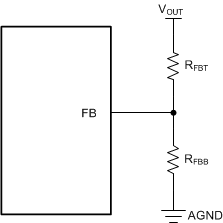SNVSCI9 June 2024 LMR36503E-Q1
PRODUCTION DATA
- 1
- 1 Features
- 2 Applications
- 3 Description
- 4 Device Comparison Table
- 5 Pin Configuration and Functions
- 6 Specifications
-
7 Detailed Description
- 7.1 Overview
- 7.2 Functional Block Diagram
- 7.3
Feature Description
- 7.3.1 Enable, Start-Up, and Shutdown
- 7.3.2 External CLK SYNC (with MODE/SYNC)
- 7.3.3 Adjustable Switching Frequency (with RT)
- 7.3.4 Power-Good Output Operation
- 7.3.5 Internal LDO, VCC UVLO, and VOUT/BIAS Input
- 7.3.6 Bootstrap Voltage and VCBOOT-UVLO (CBOOT Terminal)
- 7.3.7 Output Voltage Selection
- 7.3.8 Soft Start and Recovery from Dropout
- 7.3.9 Current Limit and Short Circuit
- 7.3.10 Thermal Shutdown
- 7.3.11 Input Supply Current
- 7.4 Device Functional Modes
-
8 Application and Implementation
- 8.1 Application Information
- 8.2
Typical Application
- 8.2.1 Design Requirements
- 8.2.2 Detailed Design Procedure
- 8.2.3 Application Curves
- 8.3 Best Design Practices
- 8.4 Power Supply Recommendations
- 8.5 Layout
- 9 Device and Documentation Support
- 10Revision History
- 11Mechanical, Packaging, and Orderable Information
7.3.7 Output Voltage Selection
In the LMR36503E-Q1 family, select variants with an adjustable output voltage option (see Section 4), and you need an external resistor divider connection between the output voltage node, the device FB pin, and the system GND, as shown in Figure 7-9. The variants with adjustable output voltage option in the LMR36503E-Q1 family are designed with a 1V internal reference voltage.
When using the fixed-output variants from the LMR36503E-Q1 family, simply connect the FB pin (identified as VOUT/BIAS pin for fixed-output variants in the rest of the data sheet) to the system output voltage node. See Section 4 for more details.
 Figure 7-9 Setting Output Voltage for Adjustable Output Variant
Figure 7-9 Setting Output Voltage for Adjustable Output VariantIn adjustable output voltage variants, an addition feed-forward capacitor, CFF, in parallel with the RFBT, can be used to optimize the phase margin and transient response. See Section 8.2.2.9 for more details. No additional resistor divider or feed-forward capacitor, CFF, is needed in fixed-output variants.